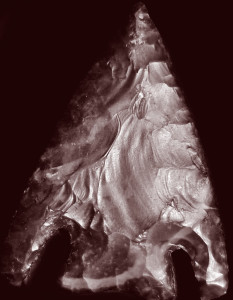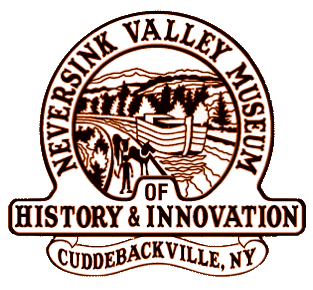Orange County Archaeology
A joint exhibition with the
O.C. Chapter of the N.Y.S. Archaeology Society
What is Archaeology?
Archaeology is the scientific recovery and study of physical evidence of past human life, and how that evidence enhances our understanding of life in the past. This evidence can be anything from gold jewelry to food scraps in a garbage dump.
Archaeologists study human life in the past through:
- Artifacts – Objects created, produced or shaped by humans – anything from stone tools such as the ones in this exhibition, to an Egyptian pyramid. Artifacts can tell us a great deal about the artistic skills and technical achievements of the people who made them.
- Modified Objects –Natural objects which have been slightly altered, but not altered enough to be an artifact. One example is heating rocks to change their crystalline structure which makes them better for flint napping (the manufacture of stone tools).
- Natural Objects –Completely natural objects found in archaeological dig sites also provide valuable information about human life and activities in the past. Raw materials (such as metallic ores) that have been moved great distances provide us with information about exchange or trade networks. Plant and animal remains provide information about domestication, eating habits, and the economy.
It is not the objects or artifacts themselves which are solely important, but the association between objects and artifacts, and what they can tell us about life in the past. Archaeologists use artifacts to study how and why relationships, patterns and processes are similar or different from one region to another, one culture to another and one period to the next. It is essential that individuals digging in an archaeological site be trained in proper excavation techniques. The most valuable information is gained by a trained professional studying the relationship of the artifacts and objects in situ (in the site which they are found).
Trained archaeologists dig an archaeological site in layers, map the site, draw profiles of soil layers, plot the exact locations of every artifact and record all observations. Then, in a laboratory setting, all of the artifacts and relevant objects are catalogued, and all of the information gathered is analyzed utilizing scientific techniques and computers. The information and the conclusions are published and available to other archaeologists, scholars, and all those who are interested. “Relic collectors” who dig up sites, using metal detectors and other means to obtain artifacts without using proper scientific procedures and record keeping, in reality are destroying history. With every shovelful of dirt thrown out, and every artifact that is removed, a page of history is destroyed. Once out of the earth, the arrowhead or pretty bottle can no longer tell us its unique story of the past. These people are no more than vandals robbing us all of our cultural heritage.
How Did Natives Get Here?
Just when the first Native American came to America is debatable. It is generally agreed that he was not native, but came here during the ice age, passing over a land connection called the Bering Strait. From the Bering Strait to New York State involved many generations of migration eastward. Following several thousand years of gradual movement, a culture of peoples who called themselves Lenni Lenape (Original People) established themselves here about 10,500 b.c.. With the retreat of the last glaciers from Orange County (8000 – 7500 b.c.) and the draining of glacial waters from the lowlands, the area was invaded with big game animals. Early humans subsisted basically as nomadic hunters, following these animals such as the mastodon and bison, which they hunted for food, clothing and other essentials.
During the short summers, they would gather some vegetable foods and edible roots, but mainly subsisted on the nourishment from the large animals they hunted. These animals were hunted with spears, headed with chipped stone projectile points. Some hunters may have used a spear thrower, or atlatl, which enabled him to throw his spear hard enough to kill the animal from a distance, instead of having to get close enough to stab it. All of the tools that they used during this time were made of chipped stone, such as scrapers, knives, and borers.
The Archaic Period — A New Environment
As the weather warmed, vegetation changed to evergreen forests that would not provide food for the large game animals. These animals eventually became extinct. With this change in the environment (around 7500 – 1500 b.c., known as the Archaic Period) the way of life of the early Americans changed as well. These people now hunted smaller game, fished and gathered food. Their sites, which were small seasonal camps, were common along Orange County creeks and rivers. The community members usually numbered around one hundred, composed primarily of nuclear or extended family groups. Hunting and curing magic were the main expressions of religion. The Native Americans of this time led a semi-nomadic life. Group movements took place within well-defined territorial limits, often following a seasonal route. They gathered edible plants, nuts and berries, such as oak and hickory nuts, and blueberries which were picked and dried for winter. Witch hazel and hemlocks provided medicine, tonics and teas.
Stone tools which had been used to hunt the now extinct big game, were not as effective against smaller game. Tools became more varied and consisted of ground and chipped stone and bone tools. They utilized spears and knives for hunting and developed items such as grooved axes, adzes, gouges, pestles and choppers. Fishing became important during this time, and they developed fishing equipment including net sinkers (tied on to fishing nets to hold them down in the water) and fish hooks. Some tools were made of bone or antler such as net weaving tools, fish hooks, sewing needles and bone tools used to make chipped stone tools.
River valleys such as the Delaware or the Neversink were perfect areas for both people and animals, with an abundance of food and water. The people who lived along the Delaware River became known as the Delaware Indians. Many Native Americans lived along the banks of the Neversink River as well. Known as the Neversink Indians, these people were a northeasterly extension of the Delaware Indians.
From Nomads to Villagers
From 1500 b.c. to 1000 b.c. a transition in the life of the Native Americans took place. Stone cooking pots developed, and cooking was done in these pots or by baking on beds of heated stones placed in shallow pits. The use of pottery was introduced, and new varieties of projectile points were created. From 1000 b.c. up to contact with the settlers in the 1500’s and 1600’s, the Native Americans began to influence their woodland environment. They cultivated plants such as corn, beans and squash.
This change to agricultural subsistence caused a major change in settlement patterns. The Native Americans were now sedentary living in villages. It is during this time that the bow and arrow was introduced. It is now that we see the first significant use of pottery, and as pottery develops throughout this stage, designs become more elaborate. Smoking pipes were innovations during this time, and we see pipes evolve from straight to elbow to platform. Amulets and the earliest known copper ornaments are found, and ceremonial burial practices become well-developed.

Short Link:
